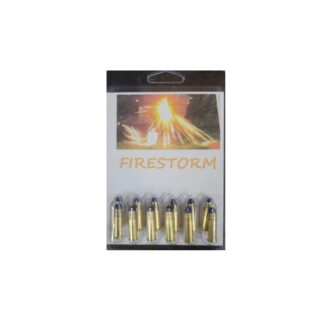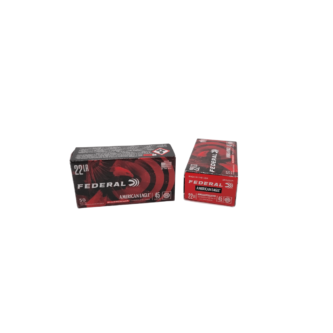
The .22 Long Rifle (.22 LR) cartridge stands as a testament to versatility and widespread popularity within the shooting community. Renowned for its affordability, low recoil, and adaptability across a spectrum of firearms, the .22 LR has cemented its position as a staple in the arsenals of both seasoned shooters, “preppers” and survivalists, and newcomers alike. Its applications span from casual plinking and target practice to small game hunting and competitive shooting, showcasing the cartridge’s multifaceted nature.
Great Deals on .22 LR Subsonic Ammo
Amidst the variety of .22 LR ammunition available, subsonic rounds carve out their niche, distinguished by their unique characteristics when compared to standard velocity rounds. Subsonic .22 LR ammunition is designed to travel at speeds below the speed of sound, eliminating the distinctive “crack” associated with supersonic bullets breaking the sound barrier. We covered subsonic, supersonic, and transonic ammunition in depth back in October of 2023 and we covered the essential knowledge of subsonic ammo specifically in January of 2024. Using subsonic ammo results in a significantly quieter shooting experience, making subsonic rounds a preferred choice for situations where noise reduction is paramount. Whether it’s for discreet pest control, minimizing disturbance to nearby wildlife, or simply for the enjoyment of a quieter shooting session, subsonic .22 LR ammunition offers shooters a specialized solution that combines the beloved traits of the .22 LR with the added benefit of reduced sound signature.
Understanding Subsonic .22 LR Ammunition
What Makes a .22 LR Round Subsonic:
Subsonic .22 Long Rifle ammunition is defined by its speed—or more accurately, its lack of speed. Unlike standard rounds that travel faster than the speed of sound, subsonic rounds are engineered to maintain velocities below this threshold, typically under 1,125 feet per second at sea level. This deliberate design prevents the round from creating a sonic boom—a sharp, loud crack produced when a projectile breaks the sound barrier. The result is a round that, when fired, produces significantly less noise, making it ideal for a variety of shooting disciplines where noise reduction is desired or necessary.
Why Shoot Subsonic .22 LR?
Quiet Shooting for Discretion and Minimizing Disturbance:
The hallmark of subsonic .22 LR rounds is their ability to offer a quieter shooting experience, making them an ideal choice for scenarios where discretion is key. This feature is particularly valued in suburban areas or close to noise-sensitive environments, where the sound of gunfire needs to be kept to a minimum. Hunters also benefit from the reduced noise levels, as it allows them to maintain stealth and avoid spooking wildlife. Additionally, the quiet nature of subsonic rounds makes them suitable for pest control activities where effectiveness must be balanced with the need for minimal disturbance.
Advantages for Training and New Shooters:
Subsonic .22 LR rounds are not only beneficial for their quiet performance but also for their role in training and introducing new shooters to the sport. The lower noise levels significantly reduce the intimidation factor associated with firing a gun, creating a more welcoming and less stressful learning environment. This aspect is crucial for building confidence and ensuring a positive first experience with firearms, particularly for young shooters or those sensitive to loud noises.
Moreover, the reduced recoil of subsonic ammunition further contributes to a comfortable learning experience. New shooters can focus on mastering the fundamentals of marksmanship, such as stance, aim, and trigger control, without the added challenge of managing significant kickback. This smoother introduction can enhance skill development and encourage continued participation in shooting sports.
The combined benefits of lower noise and recoil also make subsonic .22 LR rounds an excellent choice for recreational shooting. Families and friends can enjoy plinking and target practice sessions together, communicating more easily and spending longer periods at the range without discomfort from excessive noise.
Subsonic .22 LR rounds serve a dual purpose: they provide a solution for shooters who require or prefer a discreet and quiet option for their activities and play a significant role in fostering the growth of shooting sports. By offering a more accessible and enjoyable experience, subsonic rounds help ensure that the tradition and skills of shooting are passed down to new generations of enthusiasts.
Power and Performance
Comparing Power and Impact:
Subsonic .22 LR rounds often prompt questions regarding their power and effectiveness, especially in comparison to standard velocity rounds. While subsonic rounds are designed to travel at speeds below the speed of sound, this does not necessarily equate to a significant reduction in lethality or impact. The key distinction lies in their energy transfer and ballistic trajectory. Subsonic rounds maintain sufficient energy to be effective, particularly at closer ranges, but without the sonic boom associated with faster projectiles.
The power of a subsonic .22 LR round is more than adequate for its intended applications, delivering enough force for reliable performance within its operational envelope. The difference in impact between subsonic and standard velocity rounds becomes more pronounced at longer distances, where the slower speed of subsonic rounds leads to a more pronounced ballistic arc. Shooters will likely need to adjust their aim to compensate for this drop, especially when engaging targets at the outer limits of the subsonic round’s effective range.
The Role of Grain Weight in Subsonic .22 LR Rounds:
Grain weight, a measure of a bullet’s weight, plays a crucial role in the performance and ballistics of subsonic .22 LR ammunition. In the context of subsonic rounds, grain weight is especially important as it directly influences the bullet’s velocity, trajectory, and energy transfer upon impact. Comparing a lighter 20-grain bullet to a heavier 60-grain bullet illuminates how these differences affect shooting outcomes. You can read more about bullet weight and why it is important.
Lighter vs. Heavier Bullets:
- 38-Grain Bullet: A 38-grain subsonic bullet, being lighter, will generally have a higher velocity within the subsonic range than its heavier counterparts. This can result in a flatter trajectory over short distances, making it potentially more suitable for precision target shooting where pinpoint accuracy is desired. However, the lighter mass means it may carry less energy, impacting its effectiveness for hunting or pest control purposes. An example of this cartridge is the Aguila .22 LR Subsonic HP.
- 60-Grain Bullet: In contrast, a 60-grain subsonic bullet, being on the heavier side for a .22 LR, will travel at lower velocities but carry significantly more energy downrange. The increased mass contributes to greater momentum, allowing the bullet to maintain energy longer and provide more reliable performance for small game hunting and pest control. The trade-off, however, is a more pronounced bullet drop at distance, requiring shooters to compensate more for gravity over longer shots. An example of this type of cartridge is the Aguila .22 LR SNIPER Subsonic LRN.
Choosing the Right Grain Weight for Your Needs:
Selecting the appropriate grain weight in subsonic .22 LR rounds depends on the intended use:
- For shooters engaged in activities where noise reduction and precision are paramount, such as indoor ranges or backyard plinking, lighter grain weights might offer the desired performance without unnecessary power.
- Conversely, for outdoor applications like small game hunting where terminal performance and energy transfer are critical, opting for a heavier bullet can ensure adequate penetration and impact, even at the subsonic velocities.
Ballistic Considerations:
Understanding the ballistic characteristics of different grain weights is essential for optimizing shooting outcomes. Heavier bullets typically exhibit a more lobbed trajectory, requiring shooters to be adept at range estimation and sight adjustment. Meanwhile, lighter bullets, with their flatter trajectories, may be more forgiving at shorter ranges but lack the same impact energy as heavier options.
Effectiveness for Small Game Hunting and Pest Control:
Subsonic .22 LR rounds are particularly well-suited for small game hunting and pest control. For small game such as rabbits, squirrels, and birds, subsonic rounds offer sufficient stopping power with the added benefit of preserving meat quality by avoiding excessive damage.
The precision required when using subsonic ammunition also encourages good hunting practices, such as careful stalks and accurate shot placement. This focus on accuracy and stealth can enhance the overall hunting experience, making it both a challenge and a rewarding pursuit.
While subsonic .22 LR rounds may exhibit different performance characteristics compared to their standard velocity counterparts, they possess ample power for their designated uses. Whether for quietly dispatching pests, hunting small game, or engaging in precision shooting, subsonic rounds provide a versatile and effective solution. Shooters should consider the specific requirements of their shooting activities and choose subsonic .22 LR ammunition accordingly, taking advantage of its unique benefits to achieve the desired outcomes.
Shop Aguila Subsonic .22 LR
Effective Range of Subsonic .22 LR
The effective range of subsonic .22 Long Rifle (LR) ammunition is a critical consideration for shooters aiming to maximize the potential of these quieter, slower rounds. Understanding how the effective range differs from supersonic rounds and adjusting shooting techniques accordingly can significantly enhance accuracy and overall shooting success.
Comparing Effective Ranges:
Subsonic .22 LR rounds, by design, travel at velocities below the speed of sound, typically under 1,125 feet per second. This lower velocity means that, compared to their supersonic counterparts, subsonic rounds experience a more pronounced bullet drop at distances beyond their optimal range. While supersonic .22 LR rounds can maintain a flatter trajectory over a longer distance, subsonic rounds begin to arc more significantly as the distance increases. As a result, the effective range of subsonic rounds—where they maintain accuracy and sufficient energy for hunting or target shooting—is generally shorter.
Optimizing for Subsonic Ammunition:
Understanding the ballistic characteristics of subsonic .22 LR rounds is key to optimizing their use. For instance, a subsonic round with a heavier grain weight, such as a 60-grain bullet, will have a different trajectory and energy retention than a lighter 20-grain bullet. Heavier bullets tend to offer better stability and energy retention at subsonic velocities, which can extend the effective range slightly. However, shooters must account for the increased bullet drop at distance.
Adjusting Shooting Techniques and Sighting:
To achieve optimal accuracy with subsonic .22 LR rounds, shooters should adjust their sighting and shooting techniques. This adjustment involves understanding the specific drop pattern of the ammunition being used, which can be determined through practice and recording shot placement at various distances.
- Sight Adjustments: Using adjustable sights or scopes can compensate for bullet drop. Shooters may need to zero their firearms at a closer range than they would with supersonic rounds and practice holdover techniques to account for greater drop at longer distances.
- Windage Considerations: Subsonic rounds, traveling at lower velocities, are more susceptible to wind drift than supersonic rounds. Shooters should become adept at reading wind conditions and adjusting their aim to compensate for the potential drift.
- Practice and Familiarity: Regular practice with subsonic rounds will help shooters develop a feel for their performance characteristics. This familiarity allows for more intuitive adjustments during shooting, whether for target practice or hunting.
The effective range of subsonic .22 LR ammunition, while inherently shorter than that of supersonic rounds, does not detract from its utility and appeal. By understanding the ballistic properties of subsonic rounds, adjusting shooting techniques, and making sight adjustments for bullet drop and wind drift, shooters can effectively utilize subsonic .22 LR rounds for a variety of applications, enjoying the benefits of quieter shooting and reduced recoil.
Choosing the Right Subsonic .22 LR Ammunition
Selecting the most suitable subsonic .22 LR ammunition is crucial for achieving desired outcomes in shooting activities, whether for precision target shooting, hunting, or practicing discretion in pest control. The variety of subsonic rounds available on the market, each with different bullet weights and designs, means that shooters have the flexibility to tailor their ammunition choice to their specific needs. Here are key considerations and tips for making an informed selection:
Bullet Weight and Design:
- Consider the Application: Heavier bullets, such as those around 60 grains, generally offer better stability and energy retention at subsonic speeds, making them ideal for hunting small game where deeper penetration is needed. For target shooting, where precision is paramount, lighter bullets may provide a flatter trajectory at shorter ranges.
- Design Matters: Hollow point designs are favored for hunting due to their rapid expansion upon impact, ensuring a humane kill by maximizing tissue damage within the game. For target practice, solid or round-nose bullets might be preferred for their consistency and predictable flight paths.
Testing Different Brands and Loads:
- Compatibility with Your Firearm: Not all firearms will perform equally well with every type of subsonic ammunition. It’s essential to test various brands and loads to determine which works best with your specific firearm. Pay attention to how each round feeds, fires, and ejects, as well as its accuracy and consistency.
- Accuracy Testing: Set up a controlled environment for testing different ammunition types. Use a benchrest or another stable platform to eliminate as much human error as possible. Shoot groups with each type of ammunition at a set distance, noting the size and consistency of the groupings. This process will help identify which ammunition your firearm prefers.
- Record Keeping: Keep detailed records of your tests, including the brand, bullet weight, design, and environmental conditions. Over time, this data will become invaluable for understanding the performance characteristics of various rounds through your firearm.
Consider Environmental Factors:
- Understand that environmental factors such as temperature and humidity can affect the performance of subsonic rounds. Ammunition that performs exceptionally well in cooler conditions might not do as well in the heat. If possible, test ammunition under the conditions in which you plan to use it most frequently.
Seek Recommendations:
- Don’t hesitate to seek out recommendations from other shooters, forums, and reviews. While personal testing is invaluable, learning from the experiences of others can provide a good starting point and possibly save time and resources.
Choosing the right subsonic .22 LR ammunition involves a balance of understanding the technical aspects of the rounds and hands-on testing to assess their performance with your firearm. By considering bullet weight and design for your intended application, and thoroughly testing various options, shooters can find the subsonic ammunition that best meets their needs, ensuring satisfying and effective shooting experiences.
Shop all .22 LR Cartridges
Get Out and Shoot!
From precision target shooting and small game hunting to effective pest control and quiet recreational shooting, the .22LR has it all. The defining characteristic of subsonic .22 LR rounds—their ability to operate below the speed of sound—results in a significantly quieter shooting experience.
Through understanding the ballistic characteristics, including how bullet weight and design impact performance, shooters can make informed decisions when selecting subsonic .22 LR ammunition for their specific needs. The process of testing various brands and loads to discover the most compatible ammunition for individual firearms is an invaluable step toward achieving optimal results. This tailored approach ensures that shooters can fully capitalize on the benefits of subsonic rounds, enjoying precision and discretion in their shooting activities. So, load up on ammo, test your firearms with supersonic and subsonic rounds, and have some fun!
.22 LR Subsonic FAQ
What is the quietest subsonic 22 ammo?
The quietest subsonic .22 LR ammo typically features heavy bullets (around 60 grains) and minimal powder charge, designed specifically for noise reduction. Brands like CCI, Aguila, Atomic are often cited for their exceptionally low noise level in unsuppressed firearms.
What 22 LR ammo is subsonic?
Subsonic .22 LR ammo includes rounds designed to travel below the speed of sound, usually under 1,125 fps. Examples include CCI CB, Aguila Subsonic, and Winchester Subsonic .22 LR, among others.
Is subsonic .22 lethal?
Yes, subsonic .22 LR ammunition can be lethal, especially at close ranges. It retains enough energy for hunting small game and pest control, emphasizing the importance of responsible handling and aiming.
Can you shoot 22 subsonic without a suppressor?
Yes, you can shoot subsonic .22 LR ammo without a suppressor. While designed for reduced noise, these rounds still offer benefits in unsuppressed firearms, such as decreased recoil and less noise compared to supersonic rounds.
Will a subsonic 22 penetrate a skull?
Subsonic .22 LR rounds have the potential to penetrate a skull at close ranges, highlighting the necessity for safe firearm practices and treating every gun as if it’s loaded and capable of causing serious harm. Though the caliber is relatively small, it is by no means a “toy” caliber. It is definitely dangerous and can absolutely be deadly.
Why shoot subsonic 22lr?
Shooting subsonic .22lr is preferred for its reduced noise, making it ideal for quiet hunting, pest control, and shooting in areas where noise is a concern. It’s also beneficial for training and introducing new shooters to the sport without the intimidating noise of supersonic rounds.
What is the purpose of 22 subsonic ammo?
The purpose of .22 subsonic ammo is to provide a quieter shooting experience, minimizing disturbance to wildlife and surrounding areas. It’s suited for a variety of uses, including small game hunting, pest control, and recreational shooting, especially when noise reduction is desired or necessary.













